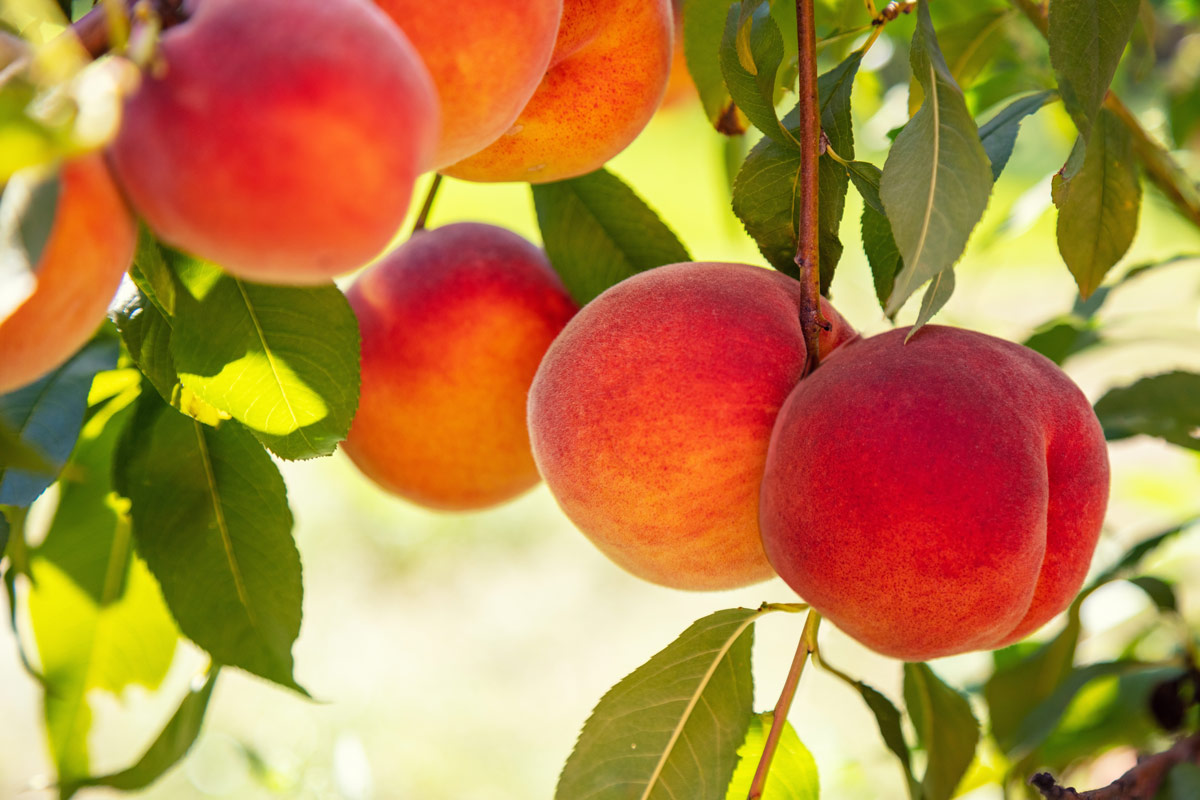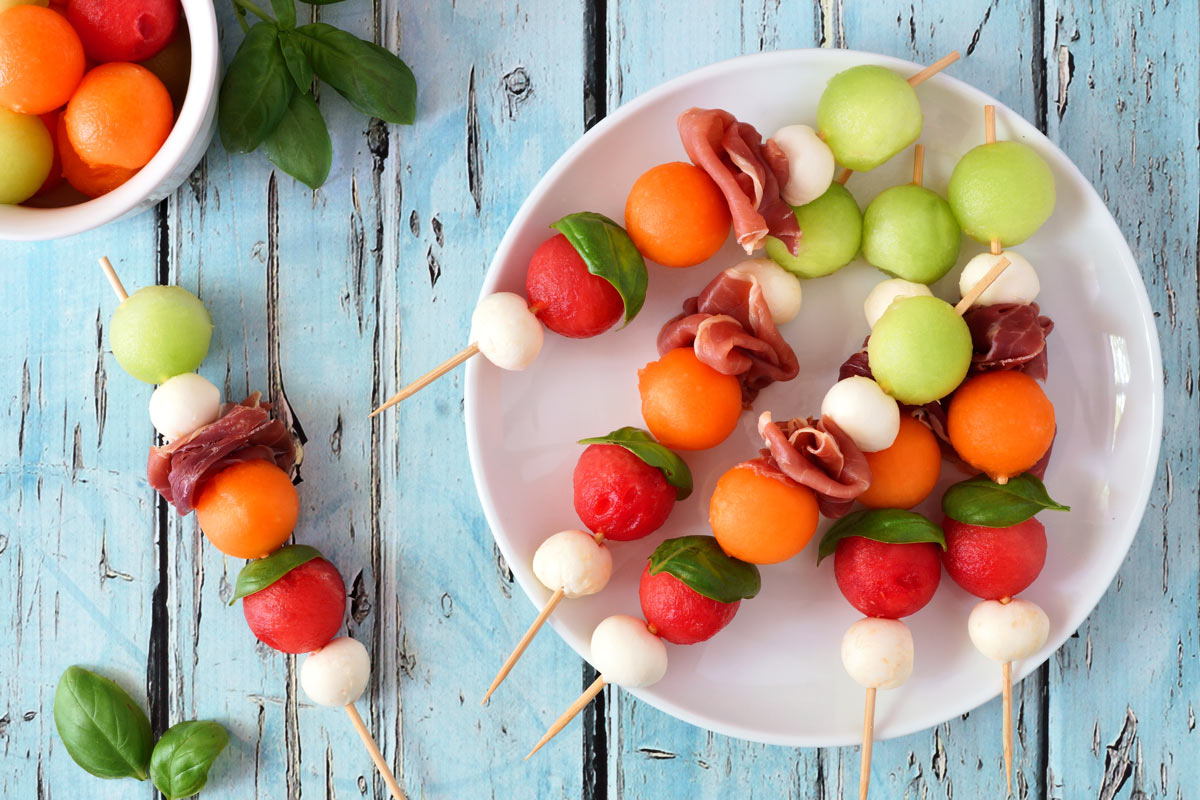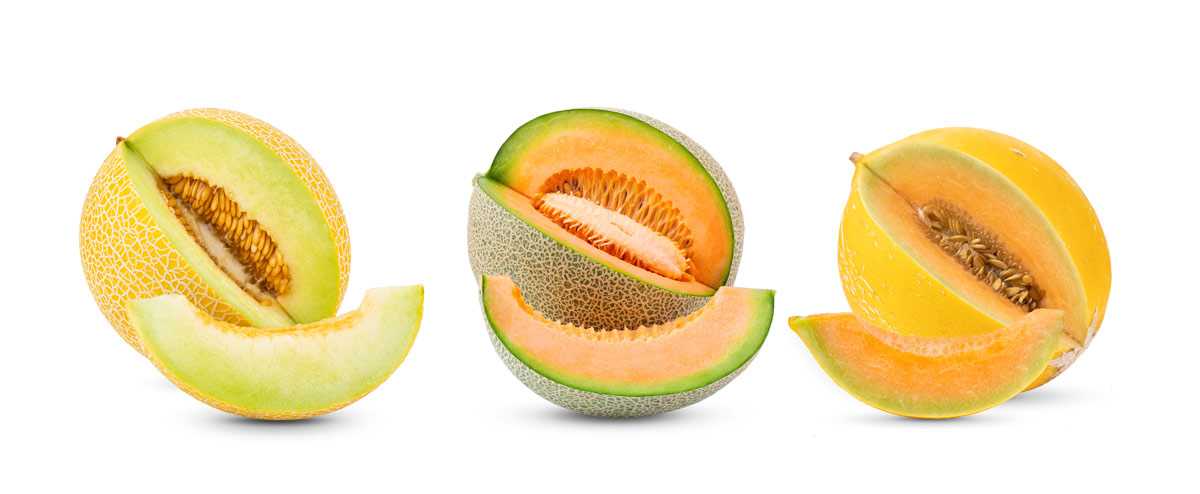Peaches-and-Cream Tart Recipe, Spotlight on Peaches, Resilience and a Diverse Gut Microbiome, Plus Secrets of Sleep
There’s nothing quite like biting into a summer peach, but when you want to make a peach dessert that has a wow factor, this tart delivers! Juicy peaches, sweet custard, and flaky pastry—who could ask for more? A lot of attention has been paid to having a healthy microbiome, and a new study adds a surprising benefit: emotional resilience. There’s also new research on another high-priority wellness item: sleep and how changes in your sleep pattern could signal health issues.
Peaches-and-Cream Tart
 Peaches-and-Cream Tart
Peaches-and-Cream TartThis recipe layers pastry cream and peach slices on freshly baked puff pastry, topped with a jam glaze. Both the peaches and the cream can be made in advance. Though there are a few steps to assembling the tart, using packaged all-butter puff pastry makes it very easy. Do read labels because many puff pastry manufacturers use artificial ingredients and no real butter in their dough. Look for the Dufour brand for flaky goodness. Note: If you already have jam with seeds, just increase the amount to 3/4 cup and pass it through a fine sieve after heating.
Ingredients
For the pastry cream:
- 4 tablespoons cornstarch
- 1/2 cup granulated sugar
- Pinch of fine sea salt
- 6 egg yolks
- 2 cups whole milk
- 3/4 cup heavy cream
- 2 tablespoons extra virgin olive oil
- 2 teaspoons pure vanilla extract or paste
For the tart:
- 8 medium ripe peaches, about 5 ounces each
- 2 tablespoons honey
- 2 tablespoons extra virgin olive oil
- 1 package frozen puff pastry, about 14 ounces, thawed according to label directions
- All-purpose or whole wheat pastry flour
- 1 medium egg
- 1/2 cup seedless raspberry jam
For serving:
- Extra virgin olive oil
- Best-quality balsamic vinegar of Modena such as Condimento Barili Exclusivi
- Freshly ground black pepper
Directions
To make the pastry cream, in a heat-safe bowl, whisk together the cornstarch, sugar, and salt. Add the yolks and whisk until the mixture is light yellow.
Step 1
Place the milk and the heavy cream in a saucepan and scald them—you should see a light skin start to form as the liquid reaches a simmer, but don’t let it come to a boil. Vigorously whisk 1/4 cup of the liquid into the egg mixture, and then slowly whisk in the rest. Transfer the mixture back to the saucepan and bring to a boil over medium heat, whisking constantly. Let it boil for 3 minutes as you continue to whisk; it should become quite thick.
Step 2
Remove from the heat and transfer to a glass serving bowl, then whisk in the olive oil and vanilla. Let it cool slightly, then press a round of parchment paper over the surface to prevent a skin from forming and chill until cold and firm, about 3 hours or overnight.
Step 3
When you’re ready to assemble the tart, cut each peach into thin slices and place them in a large baking dish or on a wide plate. Drizzle on the honey and olive oil; toss gently to coat and set aside.
Step 4
Heat your oven to 425°F. Scatter a handful of flour on a 17-inch by 13-inch piece of parchment paper and unfold the thawed dough on top of it. Use a rolling pin to roll out the seams; trim as needed to make a neat rectangle—it should be roughly 13 inches by 10 inches. Slide the parchment paper with the dough onto a rimmed sheet pan. With a sharp knife or pizza cutter, score a 1/2-inch border within the edges of the puff pastry without cutting completely through the dough. Prick the inner rectangle of dough lightly with a fork, making an even pattern across the surface. Refrigerate for 15 minutes.
Step 5
Whisk the egg in a small bowl and lightly brush it over the pastry. Bake the tart until it’s puffed and golden, 25 to 30 minutes. Let it cool to room temperature, about 15 minutes (it may deflate a bit). Spread the pastry cream over the inner rectangle, using an offset spatula to smooth the surface. Top with even rows of peach slices. Briefly warm the jam in your microwave and use a clean pastry brush to dab it over the peaches.
Serve right away.
Serves 10

Healthy Ingredient Spotlight
Choosing Peaches

Unlike some fruits that can ripen on your counter, peaches are best when allowed to ripen on the tree. Since this rarely happens with peaches grown on a commercial scale, look for peaches at farmers’ markets. Their natural fragrance should tell you they’re ready to savor.
There are two main types of peaches. Clingstone peaches, available from the middle of June, are especially sweet yet aren’t as easy to separate from their stone, or pit. Freestone peaches, which easily come away from the stone, make their appearance in late July. The lush orange-to-reddish color of peaches comes from their rich flavonoid content. Other nutrients include good amounts of vitamin C and some A, E, and K; the B vitamins niacin and folate; and minerals like iron, choline, potassium, magnesium, phosphorus, manganese, zinc, and copper.

Quick Kitchen Nugget
Freezing Peaches
Freezing fresh ripe peaches allows you to enjoy them past their season, though you’ll want to use them within a few months of freezing for optimal flavor. Rinse the peaches, pat dry, then cut them into slices or chunks. Line one or more rimmed sheet pans with parchment paper and arrange the slices on the paper, leaving some space between them. Freeze until solid, then place the slices in freezer-safe containers, filling each one to the max so that there’s little to no room for air, a cause of freezer burn.

For Your Best Health
Resilience and a Diverse Gut Microbiome
A new UCLA Health study titled “Stress-resilience impacts psychological wellbeing as evidenced by brain–gut microbiome interactions,” has found that resilient people exhibit neural activity in the brain regions associated with improved cognition and regulating of emotions, and are more mindful of and better at describing their feelings. What’s truly interesting is that the same people also exhibit gut microbiome activity linked to a healthy gut with reduced inflammation.
For the study, rather than examine microbiome activity and composition linked to disease conditions—like anxiety and depression—the researchers flipped the script and studied the gut microbiome and brain in healthy, resilient people who effectively cope with different types of stress, including discrimination and social isolation.
“If we can identify what a healthy resilient brain and microbiome look like, then we can develop targeted interventions to those areas to reduce stress,” said Arpana Gupta, PhD, senior author and co-director of the UCLA Goodman-Luskin Microbiome Center. This is believed to be the first study to explore the intersection of resiliency, the brain, and the gut microbiome.
Dr. Gupta and her team focused on methods to cope with stress, because research has shown that untreated stress can increase the risk of heart disease, stroke, obesity, and diabetes. While stress is an inevitable part of life, knowing how to handle stress may help keep people from developing diseases.
To conduct the study, published in Nature Mental Health, the researchers surveyed 116 people about their resiliency, like having trust in one’s instincts and positive acceptance of change, and separated them into two groups. One group ranked high on the resiliency scale and the other group ranked low. The participants also underwent MRI imaging and gave stool samples two or three days before their scans.
The researchers found that people in the high-resiliency group were less anxious and depressed, less prone to judge, and had activity in regions of the brain associated with emotional regulation and better cognition compared to the group with low resiliency. “When a stressor happens, often we go to this aroused fight-or-flight response, and this impairs the breaks in your brain,” Dr. Gupta said. “But the highly resilient individuals in the study were found to be better at regulating their emotions, less likely to catastrophize, and [better at keeping] a level head,” added Desiree Delgadillo, PhD, postdoctoral researcher and one of the first authors.
The high-resiliency group also had different microbiome activity than the low-resiliency group. Namely, the high-resiliency group’s microbiomes excreted metabolites and exhibited gene activity associated with low inflammation and a strong and healthy gut barrier. A weak gut barrier, otherwise known as a leaky gut, is caused by inflammation and impairs the gut barrier’s ability to absorb essential nutrients needed by the body while blocking toxins from entering the gut.
“Resilience truly is a whole-body phenomenon that affects not only your brain but also your microbiome and what metabolites that it is producing,” Dr. Gupta said. “We have this whole community of microbes in our gut that exudes these therapeutic properties and biochemicals, so I’m looking forward to building upon this research,” Dr. Delgadillo added.
The team’s future research will study whether an intervention to increase resilience will change brain and gut microbiome activity. “We could have treatments that target both the brain and the gut that can maybe one day prevent disease,” Dr. Gupta said.
As a reminder, you can boost the health of your gut microbiome by eating a diet with plenty of high-fiber foods like legumes, vegetables, and fruits, plus fermented foods like yogurt and pickles, and by limiting packaged and sugary processed foods and foods from animals fed with antibiotics. According to a separate study published in the journal Nutrients, the Mediterranean diet, with its high fiber content and bioavailability, and more than twice the important insoluble fiber in a typical Western diet, has been linked to having a beneficial microbiome.

Fitness Flash
Secrets of Sleep
Your sleep tracker might give you information not only about your sleep but also about potential chronic conditions. This is one of the findings of a study in the journal NPJ Digital Medicinethat analyzed data from 5 million nights of sleep across roughly 33,000 people. The researchers identified five main types of sleep, or sleep phenotypes, which can be further divided into 13 subtypes. They also found that how and how often a person switches between sleep phenotypes could offer two to 10 times more information relevant to detecting health conditions than just relying on a person’s average sleep phenotype alone.
Using data collected from Oura Ring, a smart ring that tracks sleep, skin temperature, and other variables, the researchers looked at individual people over a series of months, noting whether they had chronic health conditions such as diabetes and sleep apnea, or illnesses such as COVID-19 and the flu. They found that people would often move between sleep phenotypes over time, reflecting a change their health conditions and creating what resembles a person’s travel log through the data-driven sleep landscape the researchers created.
“We found that little changes in sleep quality helped us identify health risks. Those little changes wouldn’t show up on an average night or on a questionnaire, so it really shows how wearables help us detect risks that would otherwise be missed,” said Benjamin Smarr, PhD, one of the study’s senior authors and assistant professor at Jacobs School of Engineering and Halicioglu Data Science Institute at the University of California San Diego (UCSD).
In addition, the researchers highlighted that tracking changes in sleep over the long term at the population scale could unlock new insights that are relevant for public health, such as information on certain changes in patterns through these sleep landscapes that might be related to diseases.

Sleep styles
The researchers identified some trends that help intuitively separate the five sleep phenotypes.
Phenotype 1: This is what we think of as “normal” sleep—people get about eight hours of uninterrupted sleep for at least six days in a row. This is the type of sleep recommended by the National Institutes of Health and the most common sleep type researchers found.
Phenotype 2: People sleep continuously about half the nights, but they only sleep for short periods of time in bouts of less than three hours on the other nights.
Phenotype 3: People sleep mostly continuously, but they experience interrupted sleep around one night each week. The interrupted night is characterized by one period of relatively long sleep of about five hours, and one period of short sleep of less than three hours.
Phenotype 4: People again sleep mostly continuously, but they experience rare nights in which long bouts of sleep are separated by a mid-sleep waking.
Phenotype 5: People only sleep for very short periods of time every night. This phenotype was the rarest the researchers found and represents extremely disrupted sleep.
Tracking changes in sleep type
To measure how sleep phenotypes changed over time, Varun Viswanath, a fifth-year PhD student at Jacobs and the paper’s lead author, constructed a spatial model of all 5 million nights in which the phenotypes were represented as different islands composed of mostly similar weeks of sleep. Different patterns emerged over time that allowed the researchers to model each individual’s routes between islands.
From there, what helped distinguish people with chronic conditions, such as diabetes and sleep apnea, was not their average phenotype. Instead, it was how frequently they switched between islands in this sleep landscape. In this way, even if someone switched phenotypes only rarely, the fact that they did switch could still provide useful information about their health.
The data showed that it is rare for most people to go multiple months without a few nights of disrupted sleep. “We found that the little differences in how sleep disruptions occur can tell us a lot. Even if these instances are rare, their frequency is also telling. So it’s not just whether you sleep well or not—it’s the patterns of sleep over time where the key info hides,” said study co-author Edward Wang, PhD, assistant professor in the electrical and computer engineering department at UCSD.
Conversely, people did not tend to remain in patterns defined by broken sleep. But how often they visited specific disrupted-sleep patterns said a lot about how well they were doing. “If you imagine there’s a landscape of sleep types, then it’s less about where you tend to live on that landscape, and more about how often you leave that area,” said Viswanath.
This work is the first to show that researchers can quantify the changing dynamics of people’s sleep over time and use this quantification to give people better insights into their sleep health. The research also suggests that these changes in sleep may indicate a higher risk for a wide range of conditions such as chronic illness or vulnerability to infection.
Get More Recipes In Your Inbox!


